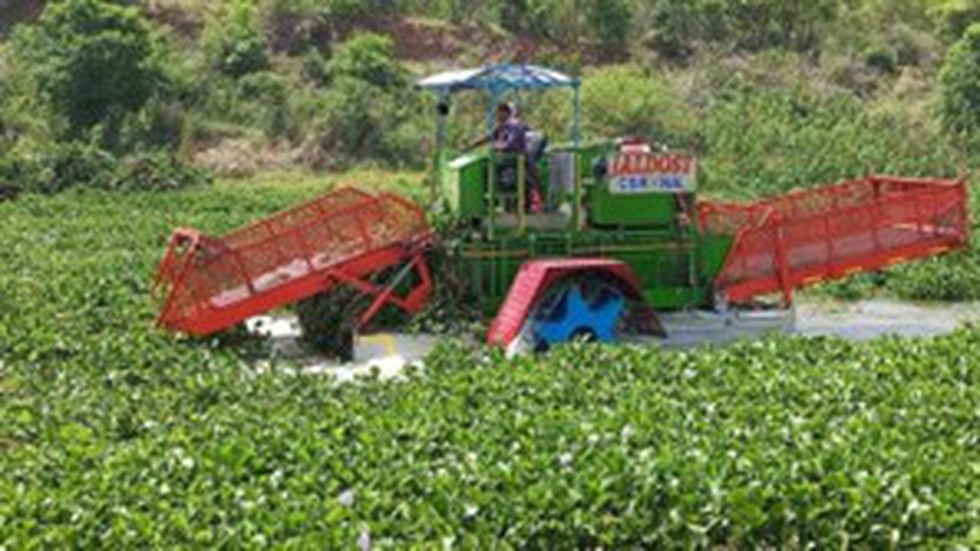
About the Yellow-bellied Sea Snake:
- The Yellow-bellied Sea Snake is a highly venomous species of snake that belongs to the subfamily Hydrophiinae (the sea snakes).
- Scientific Name: Pelamis platurus
- Distribution:
- This snake is considered the most widely-distributed snake in the world.
- It is found in tropical and subtropical waters around the world.
- It is found in tropical ocean waters in the Indian and Pacific Oceans, including the coasts of Africa, Asia, Australia, Mexico, including Baja California, and Central America.
- Features:
- Adult length averages 3 feet (0.9 metres). The snake has smooth scales and a sleekly shaped body.
- It has a distinctive bicolor pattern with a yellow underbelly and brown back and a flattened yellowtail with large black spots.
- It is a diurnal sea snake and primarily aquatic, living its entire life cycle at sea.
- This snake can spend up to 3 hours underwater without surfacing.
- Adaptations to aquatic life include reduced ventral scale size, laterally compressed body and paddle-tail for swimming, valved nostrils and palatine seal for excluding seawater, and cutaneous gas exchange for prolonging dive times.
- This species can uptake up to 33% of its oxygen requirements through the skin while diving and swimming at the surface of the water.
- They are carnivores (piscivores) and eat only fish.
- Conservation Status:
- IUCN Red List: Least Concern

What is credit rating?
- Credit rating is an assessment of the creditworthiness of a borrower, including an individual, a company, or a country.
What is Sovereign Credit Rating?
- It is an independent assessment of the creditworthiness of a country or sovereign entity.
- Governments borrow huge funds by issuing debt instruments like government bonds. Creditworthiness here means the ability of the government to pay back its debt without default.
- Sovereign credit ratings can give investors insights into the level of risk associated with investing in the debt instruments (like bonds) of a given country, including political risks.
- Standard & Poor's, Moody's, and Fitch Ratings are the three most influential credit rating agencies.
- When evaluating the creditworthiness of a country, credit rating agencies consider various economic and financial indicators of the country, including its economic growth, fiscal policies, public debt levels, political stability, and external trade position, to assign an appropriate credit rating.
- Why is it important?
- Obtaining a good credit rating is important for a country that wants to access funding for development projects in the international bond market.
- Countries with a good credit rating can attract more foreign direct investment.
- It influences the country's borrowing costs in global financial markets. Governments with higher credit ratings can borrow at lower interest rates, which can save significant amounts of money in interest payments.

About Lumpy Skin Disease (LSD):
- It is an acute to chronic, highly infectious viral disease that affects cattle.
- Causative Agent: It is caused by the lumpy skin disease virus (LSDV), which belongs to the genus capripoxvirus, a part of the poxviridae family (smallpox and monkeypox viruses are also a part of the same family).
- LSDV is not a zoonotic virus, meaning the disease cannot spread to humans.
- Symptoms:
- LSD affects the lymph nodes of the infected animal, causing the nodes to enlarge and appear like lumps on the skin, which is where it derives its name from.
- The cutaneous nodules, 2–5 cm in diameter, appear on the infected cattle’s head, neck, limbs, udder, genitalia, and perineum.
- The nodules may later turn into ulcers and eventually develop scabs over the skin.
- The other symptoms include high fever, sharp drop in milk yield, discharge from the eyes and nose, salivation, loss of appetite, depression, damaged hides, emaciation (thinness or weakness) of animals, infertility, and abortions.
- Transmission:
- by blood-feeding insects, such as certain species of flies and mosquitoes, or ticks;
- by the movement of affected animals;
- by contaminated equipment;
- directly from animal to animal in some cases;
- Treatment:
- It has no direct antiviral treatment.
- Instead, the infected animals receive supportive care, which involves the use of antibiotics, painkillers, and wound care sprays to treat symptoms.
- As there's no treatment, vaccines are used to control disease transmission.
- The disease is of economic importance as it can cause a temporary reduction in milk production, temporary or permanent sterility in bulls, damage to hides and, occasionally, death.

About Ayush Visa:
- It is specifically designed for foreign nationals looking to receive medical treatment in India through traditional Indian systems of medicine.
- This visa aims to cater to those interested in Ayurveda, Yoga, and other traditional forms of therapeutic care and wellness.
- A new chapter, e., Chapter 11A, Ayush Visa, has been incorporated after Chapter 11 - Medical Visa of the Visa Manual, which deals with treatment under the Indian systems of medicine, and accordingly, necessary amendments have been made in various chapters of the Visa Manual, 2019.
- The introduction of the Ayush Visa category is part of the country's roadmap for the Heal in India initiative.
- Heal in India initiative: It seeks to provide “integrated and holistic treatment” to the world in India and enhance patient mobility for access to world-class, affordable, and quality healthcare services”.
What is AYUSH?
- AYUSH, which stands for Ayurveda, Yoga, Unani, Naturopathy, Siddha, and Homoeopathy, is an acronym devised in 2003 to change the name of the Department of Indian Systems of Medicine and Homoeopathy (ISM & H).
- ISM & H was created in March 1995 under the Ministry of Health and Family Welfare.
- On November 9, 2014, the government elevated AYUSH to a separate ministry.
- The word AYUSH is derived from a Sanskrit phrase “ayusmanbhava" meaning long life.

About the Iberian wolf:
- It is a subspecies of Grey wolf that has been isolated from mixing with other wolf populations for over a century.
- These form the largest wolf population in Western Europe.
- It is native to the Iberian Peninsula comprising Spain and Portugal.
- They inhabit forests, inland wetlands, shrublands, grasslands, pastures, and mountainous areas.
- They live, hunt, and travel in small packs. Each pack includes the alpha male and female with their young as well as older offspring.
- The alphas are the leaders of the pack, establishing the group's territory, selecting the den sites, tracking down, and hunting prey.
- They are mainly carnivores.
- Conservation status
- IUCN: Vulnerable
Key facts about Iberian Peninsula
- It is located on Europe’s southwestern tip.
- It is part of the southern European peninsula, which comprises three peninsulas; Iberian, Balkan, and Italian peninsulas.
- Its southern tip is separated from the African continent by the narrow Strait of Gibraltar.
- This Peninsula lies between the Mediterranean Sea and the Atlantic Ocean and is separated from France by the Pyrenees mountain range.
- The highest mountain on the peninsula is Mount Mulhacén, with 3,478 m, located in the Andalusian Sierra Nevada.

About the MASI Portal:
- Monitoring App for Seamless Inspection (MASI) was developed for synchronous monitoring of the Child Care Institutions (CCIs) and their inspection mechanisms across the country.
- The National Commission for Protection of Child Rights (NCPCR) has developed this application.
- The effective and efficient functioning of the mechanism for inspection of CCIs provided under the Juvenile Justice Act, 2015 (as amended in 2021).
- The app is linked to the monitoring Portal where the automatic reports are generated.
- This App enables unified inspections by Child Welfare Committees (CWCs), State Inspection Committees, District Inspection Committees, Members of Juvenile Justice Boards (JJBs) and State Commissions for Protection of Child Rights (SCPCRs) as laid down under the JJ Act, 2015.
- It serves as a single platform for inspections of all the CCIs across the country by any of the above stated authorities.
- Regular follow-up is done before and after the completion of cycle of inspection.
- The complete reports are automatically generated on the Portal as soon as the questionnaire is filled and submitted by the authority.
Key Facts about National Commission for Protection of Child Rights
- It is a statutory body established by an Act of Parliament, the Commission for Protection of Child Rights (CPCR) Act, 2005.
- It works under the aegis of the Ministry of Women and Child Development.
- Mandate: The Commission is mandated under section 13 of the CPCR Act, 2005 "to ensure that all Laws, Policies, Programmes, and Administrative Mechanisms are in consonance with the Child Rights perspective as enshrined in the Constitution of India and the UN Convention on the Rights of the Child."
- Members:
- A chairperson who, is a person of eminence and has done outstanding work for promoting the welfare of children.
- Six members were appointed by the Central Government out of which at least two are women, who are having experience in Education, Child Health, Juvenile justice Elimination of child labour, Child psychology or sociology Laws relating to children.
- The members are appointed by the Central Government for a term of 3 years.

About JALDOST:
- It is an airboat that operates on water.
- It is designed to remove excess aquatic weed and floating waste from water bodies.
- It has a closed airtight pontoon type hull to make it inherently unsinkable.
- According to NAL, it has a hybrid propulsion system, comprising air propulsion and paddle wheel propulsion.
- How it works?
- The ability to travel through weed makes JALDOST an ideal platform to collect them and bring them to the shore.
- A steel mesh belt conveyor system fixed in the front collects the waste. The collected waste falls on the horizontal deck conveyor.
- After reaching the shore, the collected waste is unloaded by a rear conveyor system to trucks or tractors.
- NAL has developed two versions of the airboat — JALDOST Mark-1 and an upgraded version JALDOST Mark-2.
Key facts about National Aerospace Laboratories (NAL)
- It is a constituent of the Council of Scientific and Industrial Research (CSIR), India, established in the year 1959.
- It is the only government aerospace R&D laboratory in the country's civilian sector.
- CSIR-NAL is a high-technology-oriented institution focusing on advanced disciplines in aerospace.
- It has several advanced test facilities, and many of them are recognized as National Facilities.
- It has provided significant value-added inputs to all the Indian national aerospace programmes.
- It has also developed many critical technologies for the strategic sector and continues to support the mission-mode programmes of the country.
- Mandate: To develop aerospace technologies with strong science content, design and build small, medium-sized civil aircraft, and support all national aerospace programmes.

About the Lunar Codex:
- A collection of art gathered from artists will be stranded on the lunar surface as a lasting record of human creativity, even in times of war, pandemics, and economic crises.
- This programme is spearheaded by Samuel Peralta, a semi-retired physicist and art collector from Canada.
- The collection of varied digitised art will be sent to the moon as a lasting record of human creativity.
- Lunar Codex is stored on memory cards or laser etched on NanoFiche, a 21st-century update on film-based microfiche. These will ensure that the art forms reach the lunar surface safely.
- The collection of art is gathered from 30,000 artists, writers, filmmakers, and musicians from 157 countries. The art forms include images, magazines, books, podcasts, movies, and music, which are divided into four capsules.
- The first such capsule is known as the Orion collection, which has already flown around the moon when it launched on the Orion spacecraft as part of NASA’s Artemis 1 mission last year.
- In the coming months, a series of lunar landers will take the Lunar Codex capsules to various destinations, in craters at the moon’s South Pole and a lunar plain called Sinus Viscositatis.

About Kuril Islands:
- These are a set of four islands situated between the Sea of Okhotsk and the Pacific Ocean near the north of Japan's northernmost prefecture, Hokkaido.
- Japan refers to them as Northern territories, Russia calls them the Kuril Islands and South Korea named them as Dokdo islands.
- These are part of the Pacific Ring of Fire belt and have over 100 volcanoes, of which 35 are said to be active volcanoes along with hot springs.
- Both Russia and Japan claim sovereignty over them though the islands have been under Russian control since the end of World War II.
- The Soviet Union had seized the islands at the end of World War II and by 1949 had expelled its Japanese residents.
- Tokyo claims that the disputed islands have been part of Japan since the early 19th century.
What lies behind the dispute?
- According to Tokyo, Japan’s sovereignty over the islands is confirmed by several treaties like the Shimoda Treaty of 1855, the 1875 Treaty for the exchange of Sakhalin for the Kuril Islands (Treaty of St. Petersburg), and the Portsmouth Treaty of 1905 signed after the Russo-Japanese war of 1904-05 which Japan had won.
- Russia, on the other hand, claims the Yalta Agreement (1945) and the Potsdam Declaration (1945) as proof of its sovereignty and argues that the San Francisco Treaty of 1951 is legal evidence that Japan had acknowledged Russian sovereignty over the islands. Under Article 2 of the treaty, Japan had “renounced all right, title and claim to the Kuril Islands.”

About Nagarjunsagar-Srisailam Tiger Reserve (NSTR):
- Location: It is located in the Nallamala hill ranges(an offshoot of the Eastern Ghats) of Andhra Pradesh and spreads across the undivided districts of Guntur, Prakasam, and Kurnool.
- It attained the status of a Tiger Reserve in 1983.
- This is the largest tiger reserve in the country, spreading over an area of 5937 Sq. Km.
- It is named after two major dams in the area, Nagarjuna Sagar Dam and Srisailam Dam.
- Two wildlife Sanctuaries, namely Rajiv Gandhi Wildlife Sanctuary and Gundla Brahmeswaram Wildlife Sanctuary (GBM), constitute the Tiger Reserve.
- The river Krishna traverses through this Reserve for a linear distance of around 270 kilometres.
- Topography: It consists of plateaus, ridges, gorges, and deep valleys.
- Vegetation: Tropical dry deciduous forests with an undergrowth of bamboo and grass.
- Flora: The habitat has several endemics like Andrographis nallamalayana, Eriolaena lushingtonii, Crotalaria madurensis Var, Dicliptera beddomei, and Premna hamiltonii.
- Fauna:
- Top faunal species include tigers, leopards, wolves, Wild dogs, and jackals.
- The prey species are represented by Sambar, Chital, Chowsingha, Chinkara, Mouse Deer, Wild boar, and Porcupine.
- The river Krishna has Muggers, otters, and Turtles.


.png)
.png)
.png)
























































































































































.png)
.png)
.png)
.png)
.png)


.png)
.png)
.png)





.png)
.png)






.png)
.png)
.png)
.png)
.png)
.png)
.png)
.png)
.png)

.png)







.png)
.png)


.png)
.png)
.png)


.png)

.png)
.png)





.jpg)

.png)
.png)


.png)

.png)
.png)
.png)

.jpg)

.jpg)


.png)

.png)
.png)
.png)
.png)
.png)
.png)
.png)




.png)

.png)





.png)
.png)
.png)
.png)
.png)
.png)
.png)
.png)
.png)
.png)
.jpg)
.jpg)

.png)
.png)
.png)
.png)
.png)
.png)
.png)
.png)
.png)
.png)
.png)
.png)
.png)
.png)
.png)
.png)
.png)
.png)
.png)
.png)
.png)
.png)



.png)
.png)

.jpg)
.jpg)


.jpg)
.jpg)
.jpg)
.jpg)
.jpg)

.jpg)








.jpg)
.jpg)
.jpg)
.jpg)
.jpg)

















.jpg)
.jpg)







.jpg)


















.jpg)
.jpg)






























































































.jpg)
.jpg)


























.jpg)

.jpg)










.jpg)








.jpg)




.jpg)










.jpg)


















.jpg)












































.jpg)














.jpg)
.jpg)
.jpg)





.jpg)

.jpg)
.jpg)





































































.jpg)


































.jpg)
.jpg)
















































.jpg)












.jpg)


.jpg)




.jpg)
.jpg)
.jpg)

.jpg)
.jpg)
.jpg)
.jpg)

.jpg)
.jpg)
.jpg)

.jpg)
.jpg)
.jpg)
.jpg)
.jpg)
.jpg)
.jpg)
.jpg)

.jpg)


.jpg)
.jpg)
.jpg)
.jpg)
.jpg)
.jpg)
.jpg)
.jpg)
.jpg)
.jpg)











.jpg)
.jpg)





.jpg)
.jpg)
.jpg)
























.jpg)
























.jpg)









.jpg)
.jpg)







.jpg)
.jpg)









































.jpg)
.jpg)
.jpg)
.jpg)
.jpg)

.jpg)
.jpg)
.jpg)
.jpg)
.jpg)


.jpg)
.jpg)
.jpg)
.jpg)
.jpg)

.jpg)
.jpg)
.jpg)
.jpg)
.jpg)
.jpg)
.jpg)
.jpg)
.jpg)
.jpg)
.png)

.png)
.png)

.png)
.png)
.png)
.png)


.jpg)
.jpg)

.jpg)
.jpg)
.jpg)

.png)
.png)
.png)
.png)
.png)
.png)
.png)

.png)
.png)
.png)
.png)
.png)
.png)
.png)
.png)
.png)
.png)





































































-min.png)



.png)




.png)








































